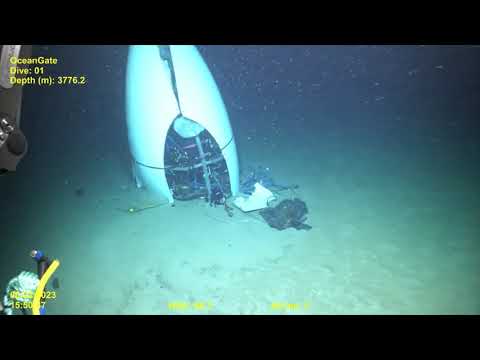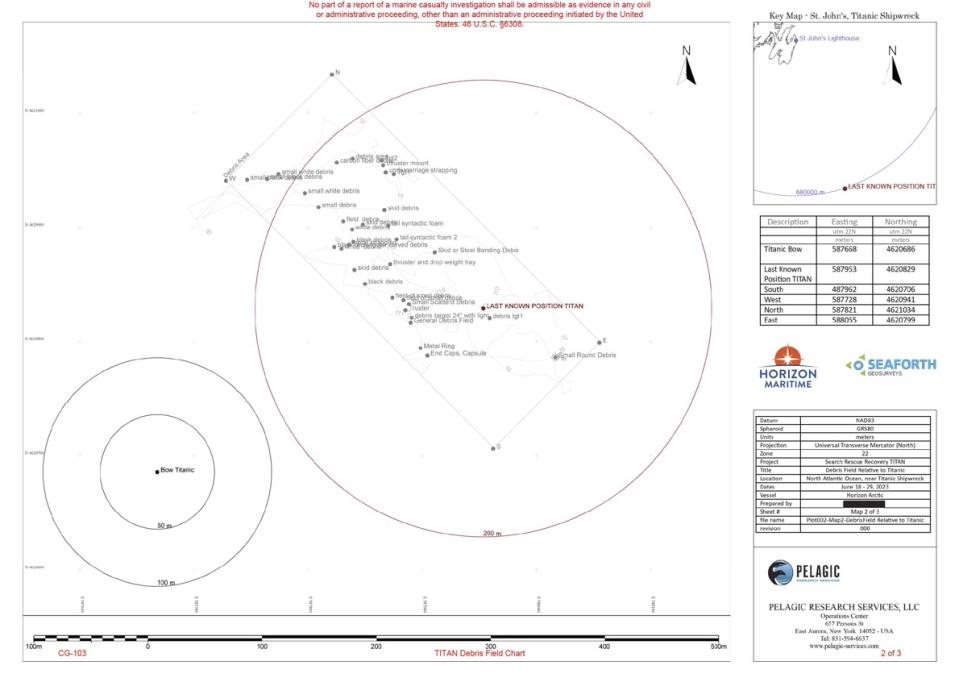The US Coast Guard has released a map of the vast debris field left behind shortly after last year's deadly OceanGate disaster Titan implosion of the submarine. Although the information was initially gathered during the salvage operations that took place from June 23 to 29, 2023, representatives made the information public on September 22 as part of the ongoing Marine Board of Investigation (MBI) hearings into the tragedy that killed five passengers during their descent to the Titanic's historic wreck. In an email to Popular scienceA USCG spokesperson confirmed that pieces of the private submarine were deposited over an area of approximately 30,000 square meters (322,917 square feet), approximately 1,600 feet away from the Titanic's bow.


OceanGate, co-founded by CEO Stockton Rush in 2007, began offering private tours to the wreck of the famous ocean cruise liner aboard its 22-foot Titan submarine in 2021. For years, however, critics and international regulatory organizations have repeatedly raised concerns about the company's approach to vehicle technology and safety measures.
On June 18, 2023, the OceanGate surface vessel lost contact with Titan about 105 minutes into his fifth overall mission of nearly 2.5 miles of descent to the TitanicThe ensuing international search scoured more than 10,000 square miles of the Atlantic Ocean over the next four days. On June 22, officials confirmed the discovery of submarine remains, indicating an almost immediate “catastrophic implosion” that likely occurred shortly after OceanGate lost contact. All five passengers, including Stockton Rush, were killed in the accident.


The USCG organized several salvage missions in the following months to recover as much of the Titan wreckage and human remains. On October 10, 2023, representatives announced the completion of the project and previewed an upcoming MBI investigation “prior to a public hearing on this tragedy.” Those hearings began on September 16 and are currently scheduled to conclude on September 27 after testimony from 25 witnesses, including former OceanGate engineers, Coast Guard officials, and underwater construction contractors.
At the time of the accident, OceanGate claimed Titan was one of three submersibles in the world capable of withstanding the pressures of the North Atlantic Ocean floor. The company previously claimed its submarine was rated for a depth range of 4,000 meters (13,123 ft). The wreck lies 12,400 ft below the ocean surface in what is known as the dark bathypelagic zone, or midnight zone. Pressures there reach about 375 atmospheres, which exerts the equivalent of 5,500 pounds per square inch (psi) of force on an object — about 1,500 psi more than is estimated for a bite from a great white shark.
[Related: What the US Coast Guard found on their last OceanGate Titan salvage mission.]
Such inhospitable environments mean that even the slightest deformity or flaw in a ship's structure would cause an almost instantaneous implosion in less than 20 milliseconds, faster than a human brain could register the event. The USCG's debris field map appears consistent with initial estimates that Titan delamination, causing the carbon fiber hull to split horizontally as water filled the space, crushing the ship. Debris was then thrown out, while the larger end caps fell to the ocean floor.
Although deep ocean currents may have influenced the distribution of the debris, a spokesperson said Popular science the USCG “can confirm that the wreck was discovered in the immediate vicinity of the submarine's last recorded position Titansuggesting that the implosion was the primary force behind such a large wreckage field. Despite the recovery of hundreds of fragments from the site, a few significant chunks of Titan—as seen in video footage also recently released during the MBI hearings—were too heavy to bring to the surface.
“The majority of the wreckage has been recovered,” the USCG spokesperson explained, adding that: “The carbon fiber hull fragments still on the seafloor are not expected to move from their original locations.”

